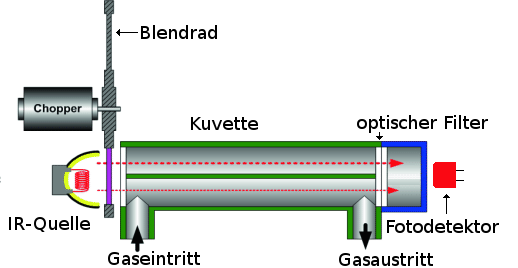Non Dispersive Infrared Sensor ( NDIR)
The principle of non-dispersive infrared absorption uses the properties of individual gases in absorbing specific frequencies of infrared light which the sample gas is exposed to. The sensor measures the composition and concentrations by analysing the frequencies and extent of light absorbed. As all infrared light of all frequencies emitted from the light source is utilised, it is referred to as "non-dispersive."
Non-dispersive type infrared absorption sensors are widely used for various types of gas measurements such as carbon monoxide (CO), carbon dioxide (CO2), and hydrocarbons (HC). Usually this type of gas sensor is large with a bulky metal casing to accommodate the optical path and the rotary device of the mechanical chopper; only few are compact enough for installation in portable measuring devices.
Conventional non-dispersive infrared absorption sensors consist of four elements: the light source, the detector element (e.g. light detector element), the optical path and the mechanical chopper).
Function principle
Of the infrared light periodically emitted from the light source, only an amount proportionate to the concentration of CO2 present in the gas sample is absorbed by the infrared detector at a wavelength of 4.3μm. The detector with its integrated filter is configured to be sensitive only in the narrow wavelength band centred on 4.3μm and emits an electric signal (proportionate to the infrared light it absorbs) which accordingly indicates the actual concentration of CO2 present.
